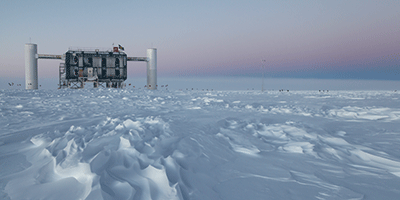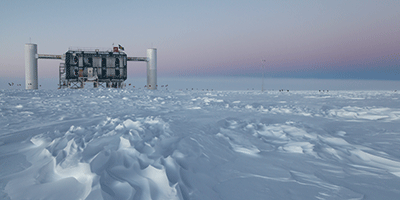IceCube Neutrinos Pass Flavor Test
The IceCube Neutrino Observatory at the South Pole is a large array of photodetectors buried in ice. In 2013, the instrument reported signals from the highest energy neutrinos ever observed. Now, two teams of researchers have independently estimated the type, or flavor, of these neutrinos. As opposed to an earlier analysis, these new results are consistent with the neutrinos coming from cosmically large distances. Further work may begin to probe the physics going on at the neutrino sources.
Cosmic accelerators, such as active galactic nuclei, should produce high-energy neutrinos with a flavor distribution that reflects the underlying physics. For example, pion decay results in mostly muon neutrinos and no tau neutrinos, but other scenarios exist with different initial flavor distributions. Nevertheless, because of neutrino mixing, the flavor ratio emitted by the source is not the same as that observed at Earth. In the case of pion decay, the observed electron:muon:tau ratio should be roughly 1:1:1. Other astrophysical scenarios predict a different ratio.
IceCube cannot definitively measure the flavor of its neutrinos, but the instrument can tag muon neutrinos, and a small fraction of tau neutrinos, by the appearance of long “tracks” in the detector (as opposed to pointlike “showers”). Using the instrument’s data from 2010 to 2012, researchers not affiliated with IceCube claimed the best-fit flavor ratio was 1:0:0, i.e., no muon or tau neutrinos. This unexpected result implied exotic physics, such as rare neutrino decays or mixing with sterile neutrinos.
Two groups have now analyzed a larger data set (covering years 2010 to 2013). The first work, conducted by the IceCube collaboration, identifies a total of high-energy neutrinos (above tera-electron-volts). The team shows that the number of tracks to showers is incompatible with exotic flavor ratios, such as 1:0:0 and 0:1:0. A similar analysis was performed by theorists at Italy’s Gran Sasso Science Institute in L’Aquila and the Gran Sasso Laboratories in Assergi. They focus on a higher energy range (above tera-electron-volts) and find the ratio of tracks to showers is consistent with several astrophysical (nonexotic) models. Future data and analysis, which may include a method for tagging tau neutrinos, could eventually distinguish between these different source models.
This research is published in Physical Review Letters.
–Michael Schirber





